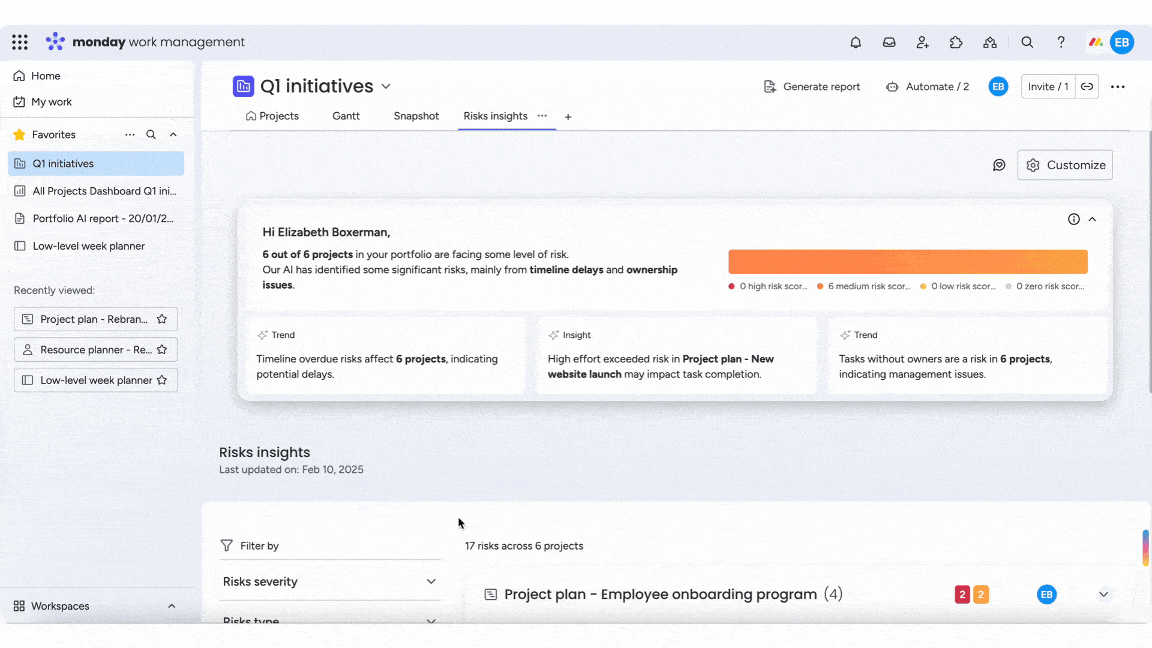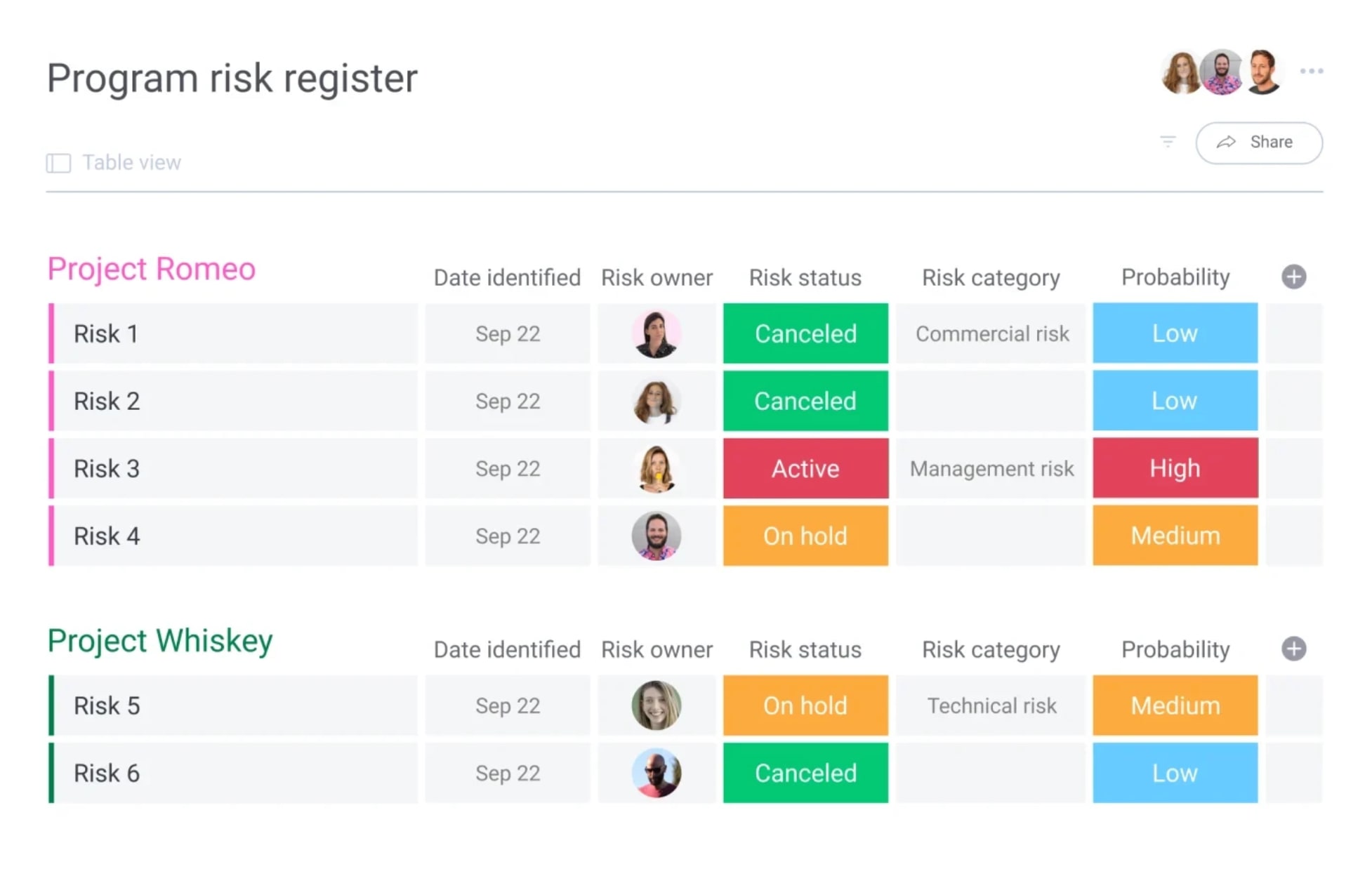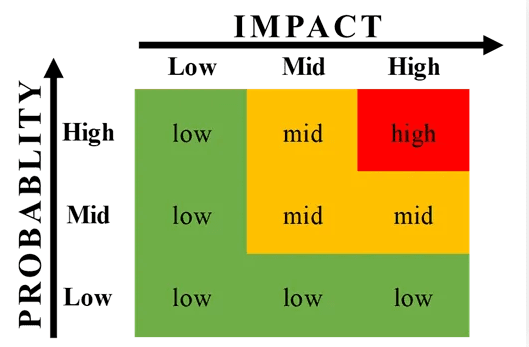Your business depends on suppliers to deliver for customers, but in today’s global supply chain, one weak link can trigger major disruptions, halt production, and damage your bottom line. Managing these vendor relationships effectively is critical for operational stability.
Proactive supplier risk assessment builds supply chain resilience by systematically evaluating vendors for financial, operational, and security threats before they become problems. This structured approach transforms uncertainty into strategic advantage.
This guide covers the essentials of effective risk management: the five critical types of supplier risk, a step-by-step assessment process, and downloadable templates to create repeatable systems — helping you shift from reactive problem-solving to streamlined execution.
Key takeaways
- Recognize the impact of supplier failure: disruptions can halt production, damage reputation, and reduce revenue, making proactive risk assessment essential for business continuity.
- Cover five core risk areas: evaluate financial stability, operational performance, compliance, cybersecurity, and reputational exposure to identify vulnerabilities.
- Apply a consistent five-step process: define criteria, collect data, assess risk levels, calculate scores, and create mitigation plans for reliable supplier evaluations.
- Enhance transparency with monday work management: use AI-powered analysis, customizable workflows, and real-time dashboards to centralize supplier risk management.
- Start small and scale strategically: begin with your most critical suppliers, refine your process using templates, and expand to your full vendor network over time.
What is supplier risk assessment?
is the process of evaluating potential threats that vendors may pose to your operations. It involves examining factors such as financial stability, compliance, performance reliability, and cybersecurity to understand how a supplier could impact business continuity.
In many ways, it serves as a health check for your supply chain — ensuring every partner meets the standards needed to keep operations stable and resilient.
Why supplier risk assessment matters
When a supplier fails, the impact ripples through your entire organization. Production stops. Customers wait. Revenue drops.
Modern supply chains are interconnected networks where one weak link affects everything else. In fact, supply chain challenges are the norm, not the exception, with a recent McKinsey survey finding that nine in ten respondents encountered them in 2024.
For example, a cybersecurity breach at your IT vendor exposes your data. A quality issue with your parts supplier damages your reputation. Financial troubles at a key vendor could also leave you scrambling for alternatives.
The business case for supplier risk assessment comes down to three critical outcomes:
- Protection from disruption: identify weak points before they break.
- Negotiating power: use risk profiles to secure favorable terms.
- Strategic advantage: build supply chains that adapt to change.
Key components of effective assessment
A complete supplier risk assessment examines multiple dimensions of risk. You need structured methods to collect data, analyze threats, and incorporate a risk management process to make decisions.
Start with reliable information gathering. This includes financial records, compliance certificates, performance data, and operational capabilities. Without good data, even the most sophisticated assessment framework fails.
Risk categorization transforms raw data into actionable insights. Group risks by type — financial, operational, compliance, strategic — to prioritize your response and allocate resources effectively. Incorporating a risk register helps systematically document these categories.
Downloadable supplier risk assessment templates
Effective supplier assessment depends on structure and consistency. Templates give you both — turning complex evaluations into clear, repeatable steps. They also make it easier to compare vendors, document findings, and build a reliable risk management process over time.
Below are four essential templates designed for different stages of supplier evaluation — from basic checks for new vendors to detailed assessments and ongoing performance monitoring for critical partners.
Basic risk assessment template
Start here if you’re new to supplier risk management or evaluating low-impact vendors. If your team also handles project risk management, this template covers the essentials without overwhelming your team.
The basic template captures supplier contact details, financial indicators, operational capacity, and compliance status. Simple scoring lets you complete assessments quickly while still identifying major risks.
This streamlined approach works when resources are limited or suppliers have minimal business impact. It builds familiarity with risk concepts that you can expand later.
Comprehensive supplier evaluation template
Use this template for critical suppliers or complex relationships that require deeper analysis. It covers key areas such as:
- Financial stability: credit ratings and long-term viability.
- Operational capacity: production capability and reliability.
- Quality systems: certifications and performance history.
- Strategic alignment: fit with your business goals.
Combine data from quantitative metrics and qualitative insights, then record findings and next steps in dedicated sections. Ideal for teams that need detailed documentation for strategic decisions and audits.
Risk scoring and comparison template
Convert subjective assessments into objective numbers. Incorporating a risk matrix along with standardized scoring can help rank and compare multiple suppliers.
Weight different risk categories based on importance. Financial stability might matter most for critical suppliers. Compliance factors could take priority in regulated industries.
The numerical output tracks trends over time and triggers action when scores drop below thresholds, perfect for vendor selection and ongoing performance monitoring.
Vendor due diligence checklist
Checklists ensure you cover every evaluation area while creating an audit trail. Organize verification points by risk category with space for evidence and findings.
Mark each item as complete, not applicable, or needing follow-up. This systematic approach prevents oversights and provides quality assurance.
The checklist format works especially well for teams new to assessment or organizations requiring consistent compliance documentation.
Try monday work management5 critical types of supplier risks explained
Different risk types require different evaluation approaches. Comprehensive risk identification can hels you conduct thorough assessments and develop targeted responses.
Risk categorization also guides resource allocation. High-impact risks get more attention. Lower-priority risks receive simpler management approaches.
1. Financial risk indicators
Financial instability threatens your supplier’s ability to deliver. Watch for these warning signs that indicate potential problems:
- Credit rating decline: deteriorating scores signal cash flow issues.
- High debt levels: excessive leverage limits investment capacity.
- Customer concentration: heavy reliance on few clients creates vulnerability.
- Payment delays: late payments to their suppliers indicate stress
Evaluate both numbers and business model sustainability. Declining revenues, management turnover, or industry disruption all point to future problems, highlighting the need for risk mitigation strategies.
2. Operational and performance risks
Even financially stable suppliers can fail operationally. Conducting a risk analysis is crucial to identify potential disruptions to your operations.
Capacity constraints can also emerge during growth or peak demand. Can your supplier scale production? Do they have backup facilities? What happens if key equipment fails?
Quality control breakdowns create downstream problems. One bad batch triggers customer complaints, rework costs, and potential recalls. Assess their quality systems, certifications, and track record.
3. Compliance and regulatory risks
Supplier violations become your violations. When vendors fail to meet legal standards, you face fines, sanctions, and operational restrictions.
Data protection tops the compliance list. Any supplier touching personal data must demonstrate GDPR or CCPA compliance. One breach exposes both organizations.
Industry-specific requirements vary widely. Pharmaceutical suppliers need FDA compliance. Financial services vendors must meet SOX requirements. Know your standards and verify supplier adherence.
4. Cybersecurity and data protection risks
Digital connections create digital vulnerabilities, and every supplier with system access represents a potential entry point for attackers. This risk is growing, with a 2024 benchmark report showing that 62% of organizations experienced a disruption related to cybersecurity from their supply chain, a 13% increase from the previous year.
Key cybersecurity risks to evaluate include:
- Access controls: how do they manage user permissions?
- Data encryption: is information protected in transit and storage?
- Incident response: can they detect and respond to breaches quickly?
- Security certifications: do they maintain ISO 27001 or SOC 2 compliance?
Remember that your security is only as strong as your weakest supplier link.
5. Reputational and ethical risks
Supplier scandals become your scandals. Labor violations, environmental damage, or ethical lapses at supplier facilities damage your brand by association.
Social media amplifies these risks. What once stayed local now goes global in hours. A supplier’s poor practices can trigger boycotts of your products.
Evaluate supplier practices against your values. Review their labor policies, environmental records, and business ethics. Also ensure that you monitor news and social sentiment for early warnings.

How to conduct supplier risk assessment in 5 steps
Follow this systematic approach to ensure consistent, thorough evaluations. For additional help, incorporating risk tracking methods can further help create a complete picture of supplier risk.
Step 1: define your risk criteria
Adopting an enterprise risk management approach ensures alignment with business objectives. Your criteria should reflect risk tolerance, industry requirements, and strategic priorities.
Weight categories based on business impact. Critical suppliers might prioritize financial stability. Regulated industries could emphasize compliance factors.
Document scoring scales, evidence requirements, and escalation procedures. Make sure every evaluator understands how to apply criteria consistently.
Step 2: collect supplier information
Comprehensive data collection forms your assessment foundation. Gather information from multiple sources for a complete picture:
- Supplier questionnaires: tailored to your risk criteria.
- Financial statements: recent reports showing fiscal health.
- Third-party reports: credit ratings and industry analysis.
- Reference checks: feedback from other customers.
Verify self-reported information against independent sources. Suppliers naturally present their best face — external data reveals the full picture.
Step 3: evaluate risk categories
Assess each risk category using your predefined criteria. Incorporating a risk management plan can help document both scores and observations for future reference.
Look beyond current state to future trends. A supplier might seem stable today but face emerging challenges tomorrow.
Balance quantitative metrics with qualitative insights. Numbers tell part of the story — context completes it.
Step 4: calculate risk scores
Combine category assessments into overall risk scores. Using risk management software can streamline your weighting system to reflect both probability and potential impact.
Create risk profiles summarizing key findings. These profiles support decision-making and communicate results to stakeholders.
Also use consistent scoring across all suppliers: this enables fair comparisons and data-driven vendor selection.
Step 5: create mitigation plans
Develop specific actions for identified risks. Focus on high-priority issues first, balancing mitigation costs against potential impacts.
Mitigation strategies might include:
- Contract modifications: add performance guarantees or exit clauses.
- Increased monitoring: schedule more frequent reviews.
- Backup suppliers: develop alternatives for critical items.
- Risk transfer: require insurance or performance bonds.
Assign specific ownership and timelines for each action. Monitor effectiveness and adjust as conditions change.
Try monday work managementBest practices for ongoing risk management
Supplier risk assessment isn’t a one-time event. Markets shift. Suppliers evolve. New risks emerge. Successful organizations build ongoing management into their operations.
Not every supplier needs the same attention. Risk-based monitoring focuses resources where they matter most.
Keep in mind and be sure to follow the best practises below:
Set assessment standards
Consistent standards enable fair comparisons and objective decisions. Document your standards and apply them uniformly.
Quality assurance maintains accuracy. Regular calibration sessions ensure different evaluators reach similar conclusions.
Review standards periodically. Update them to reflect new requirements, regulations, or best practices.
Schedule regular review cycles
Match review frequency to risk levels. Critical suppliers might need quarterly reviews. Low-risk vendors could be annual.
Trigger immediate reassessment for major changes:
- Financial distress signals: credit downgrades or payment issues.
- Operational disruptions: quality problems or delivery failures.
- Compliance violations: regulatory actions or data breaches.
- Management changes: new leadership or ownership.
Automated scheduling ensures reviews happen on time. Integration with calendars and project systems streamlines the process.
Enable cross-team collaboration
Different departments bring different expertise to risk assessment, a practice that is especially critical in large organizations where research shows only 61% of employees in large enterprises are satisfied with transparency. Procurement knows commercial relationships. IT evaluates cybersecurity. Legal assesses compliance.
Modern and intuitive platforms like monday work management facilitate this collaboration through shared workspaces and automated notifications. Everyone contributes their expertise while maintaining visibility into the overall assessment.
Finally, define specific roles to prevent confusion: regular communication keeps stakeholders aligned on findings and actions.
Maintain comprehensive documentation
Good documentation supports audits, provides historical context, and enables knowledge transfer. Keep records organized, accessible, and current.
Version control tracks changes over time. See how assessments evolve and why decisions were made.
Secure storage protects sensitive information while ensuring authorized access. Cloud platforms provide the security and accessibility needed for effective documentation.
Automate repetitive processes
Automation improves consistency while freeing resources for analysis. Common automation opportunities include:
- Data collection: pull financial data from external sources.
- Score calculation: apply formulas consistently across assessments
- Report generation: create standardized outputs automatically
- Workflow routing: move assessments through approval chains
Integration reduces manual data entry. Connect assessment platforms with financial systems for automatic updates.

How modern platforms help transform risk assessment
Supplier risk management is no longer a static, once-a-year exercise. Modern platforms turn it into an ongoing process where risks are tracked, updated, and resolved in real time.
By combining automation, data integration, and collaboration tools, these systems help organizations move from manual checklists to intelligent, connected workflows. The following sections outline the core benefits and features driving this transformation.
Benefits of digital risk management platforms
Digital transformation delivers multiple advantages for risk management teams:
- Centralized data: single source of truth eliminates version conflicts.
- Automated workflows: assessments progress without manual intervention.
- Real-time insights: see risks as they emerge, not months later.
- Collaborative evaluation: multiple stakeholders contribute efficiently.
These benefits compound as you scale. What works for 10 suppliers works for 1,000.
Essential features for risk assessment platforms
The most effective platforms combine automation, visibility, and collaboration to simplify complex evaluations. The table below highlights key features that strengthen supplier risk management and the business impact each delivers.
| Feature | Purpose | Business impact |
|---|---|---|
| Risk scoring engine | Automated calculation and weighting | Consistent, objective assessments |
| Dashboard reporting | Visual risk summaries and trends | Executive visibility and decision support |
| Integration capabilities | Connect with existing systems | Streamlined data flow and reduced manual entry |
| Workflow automation | Standardized assessment processes | Improved efficiency and compliance |
| Collaboration tools | Multi-stakeholder input and review | Enhanced assessment quality and buy-in |
| Alert systems | Proactive risk notifications | Early warning and rapid response |
Integration with your tech stack
Modern platforms connect with your existing systems. ERP integration provides transaction data. Financial systems update supplier information automatically.
These connections eliminate data silos and manual updates. Information flows seamlessly between systems, keeping assessments current.

Scale supplier risk management with monday work management
As supplier networks expand, manual processes become harder to maintain. Modern work management platforms such as monday work management bring structure, automation, and real-time visibility to every stage of the supplier risk process.
With customizable workflows, AI-driven insights, and collaborative dashboards, teams can scale risk management efficiently while maintaining consistency across global operations.
The features below show how to turn complex supplier oversight into a streamlined, data-driven system.
AI-powered risk analysis and categorization
AI transforms how you process supplier information, tapping into a growing workforce confidence where research shows 80% of Millennials believe AI can help them do their jobs better. The “Assign labels” AI Block categorizes suppliers by risk level automatically. “Extract info” pulls key data from documents and questionnaires.
This automation reduces assessment time while improving accuracy. AI learns your patterns, becoming more effective over time.
Automated assessment workflows
Workflows move assessments through required steps automatically. Workflow assignments ensure the right people participate at the right time.
Deadline reminders prevent delays. Escalation procedures handle exceptions. Templates provide consistency while allowing customization.
Real-time risk dashboards
Instant visibility turns data into action. Dashboards consolidate supplier risk across your organization so leaders can identify issues and make informed decisions quickly.
- Trend tracking: spot risk patterns and performance shifts early.
- Customizable widgets: display the metrics most relevant to each role or department.
- Automated alerts: notify stakeholders when thresholds are exceeded or new risks emerge.
These insights help teams respond faster, improve accountability, and maintain a proactive approach to supplier management.
Collaborative risk evaluation
Cross-functional teams contribute expertise through shared workspaces. Comment threads capture discussions. Document sharing maintains version control.
Approval workflows ensure proper review before finalization. Audit trails track all changes and decisions.
Try monday work managementFrequently asked questions
How often should I reassess my suppliers for risk?
Reassess critical suppliers quarterly to stay ahead of emerging issues, and review low-risk vendors annually to ensure continued reliability. You should also conduct an immediate reassessment whenever major changes occur — such as financial instability, compliance violations, ownership shifts, or significant operational disruptions.
What's the difference between vendor risk assessment and supplier risk assessment?
The difference between vendor risk assessment and supplier risk assessment is minimal, as they are essentially the same process. "Vendor" typically refers to service providers while "supplier" refers to goods providers, but the terms are used interchangeably. "Vendor" typically refers to service providers while "supplier" refers to goods providers, but the terms are used interchangeably.
Which suppliers should I prioritize for risk assessment?
Prioritize suppliers based on business criticality, spending volume, and potential disruption impact. Start with suppliers whose failure would significantly impact operations or represent high financial exposure.
What regulatory requirements apply to supplier risk assessment?
Regulatory requirements vary by industry. Financial services, healthcare, and government contractors face the strictest mandates requiring documented due diligence and ongoing third-party monitoring.
How can small businesses implement supplier risk assessment effectively?
Small businesses should start with basic templates for critical suppliers. Focus resources on highest-impact vendors and expand processes gradually as the business grows and gains risk management experience.
What information do I need to collect for supplier risk assessment?
Collect financial statements, insurance certificates, compliance documentation, security certifications, and operational capacity information. Tailor requirements to specific risks associated with each supplier relationship and industry.
 Get started
Get started 

